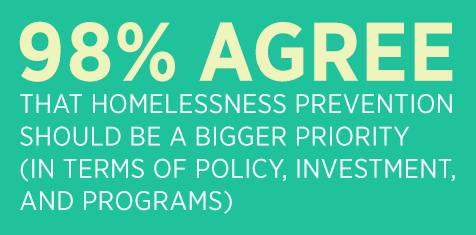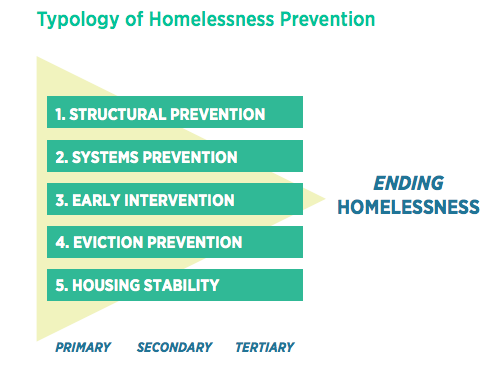Over two hundred years ago, Benjamin Franklin said, “An ounce of prevention is worth a pound of cure”. Since that time, most people have come to understand the importance of prevention in dealing with major social, economic, and health problems. For instance, it is better to prevent cancer, measles, the flu, or other illnesses than have to deal with the consequences. This kind of thinking has influenced how we approach crime, road safety, and many other problems.
So how about homelessness? For decades we have relied on emergency services to help those experiencing homelessness. Emergency shelters, soup kitchens, and day programs, meant to be short-term supports, have become the main response to manage homelessness. While we will always need emergency services to help those in crisis, it’s past time we move in a new direction and look for ways we can support people to avoid homelessness. Housing First points the way to helping people permanently exit homelessness. But what is and what should the role of homelessness prevention be?
In March of this year, the Canadian Observatory on Homelessness conducted a nation-wide survey to capture people’s views on homelessness prevention. A total of 633 Canadians answered the survey. The largest percentage of respondents identified themselves as service providers (40%) and 11% of respondents were people with lived experience of homelessness.
The results were compelling. Eighty-nine percent agreed that it is possible to prevent homelessness in Canada; however, only 29% believed their communities have a good understanding of what homelessness prevention involves. Respondents noted that in their communities prevention was a much lower priority (31%) than housing and supports (61%) and even more so than emergency services (71%).
More significantly, the survey indicated strong support for making homelessness prevention more important priority for government. Over 98% made this point (92% strongly agreed). As the Government of Canada embarks on a process of reviewing its homelessness strategy and investment (HPS expires in 2019), over 97% of survey respondents said the prevention of homelessness should become a major priority. This is important because until now, beyond words and rhetoric, prevention has not really figured into how we respond to homelessness in Canada.
All of this begs the question, what do we mean by the prevention of homelessness? Today, the Canadian Observatory on Homelessness launches A New Direction: A Framework for Homelessness Prevention with the intention of beginning a national conversation about how we can prioritize homelessness prevention. The survey informed our thinking on the framework and on making the prevention of homelessness a policy and practice priority. The framework provides the language and clarity to begin that conversation. It includes a definition of the prevention of homelessness and a typology that outlines the legislation, policies, collaborative practices, and interventions that will reduce the risk of homelessness.
The international context
Although Canada hasn’t made homelessness prevention a priority, other countries have been making headway. It is important to note that there are some great local homelessness prevention programs across Canada, but none have been taken up systematically. Alternatively, Australia’s Reconnect program provides outreach and support to youth at risk of homelessness in schools. Finland developed an action plan for cross-sectoral collaboration on prevention. The US has focused on preventing veteran homelessness. Germany and the UK saw a reduction in homelessness when they began running homelessness prevention interventions.
Homelessness prevention legislation is at the center of a lot of the international success because it sets out the government’s prevention goals, lays out different government departments’ responsibilities and how they must work together, and provides the policy and funding for local communities. Wales, Ireland, and Britain have all passed legislation setting out a duty to provide information and assistance to those who are at risk of homelessness. This legislation is rooted in a human rights approach that believes everyone should have access to safe and adequate housing. Over 96% of our survey respondents agreed that housing is a human right.
Defining homelessness prevention
The COH framework creates a definition of homelessness prevention so that we can be clear on what we’re talking about. In our survey, 93% of respondents agreed with our proposed definition.
|
Definition of the Prevention of Homelessness Homelessness prevention refers to policies, practices, and interventions that reduce the likelihood that someone will experience homelessness. It also means providing those who have been homeless with the necessary resources and supports to stabilize their housing, enhance integration and social inclusion, and ultimately reduce the risk of the recurrence of homelessness. The causes of homelessness include individual and relational factors, broader population-based structural factors, and the failure of many public institutions to protect people from homelessness. This suggests that homelessness prevention must not only include interventions targeted at individuals, but broader structural reforms directed at addressing the drivers of homelessness. That not only communities but all orders of government, and most departments within have a responsibility to contribute to the prevention of homelessness is in keeping with a human rights perspective. |
The definition sets out the nature and scope of homelessness prevention. Emergency services and the supports they provide, while important, are not homelessness prevention unless they are offered in the context where people have immediate access to housing. In the prevention survey, 94% of respondents, many of whom are service providers in the homelessness sector, agreed that more resources should go to homelessness prevention even if it means in the long run there will be less need for existing services and supports.
The public health model
The framework is guided by the public health model of prevention, which has been used for decades to prevent disease and more recently in crime prevention and to prevent school dropout. The public health model is broken down into three categories:
- Primary prevention – These are prevention efforts that work at the structural level to help everyone. Primary prevention can be unpacked further:
- Universal prevention – Applies to the population as a whole, such as poverty reduction strategies and having an adequate supply of affordable housing.
- Selected prevention – Interventions aimed at a particular group, such as school-based programs and anti-oppression strategies for those facing discrimination.
- Indicated prevention – Prevention strategies for individuals at greatest risk of homelessness, such as support for families experiencing violence and for individuals with mental health and/or addictions challenges.
- Secondary prevention – Programs and practices to help those at immediate risk of homelessness or who have recently become homeless. Examples include evictions prevention and family mediation.
- Tertiary prevention – Making sure those who have experienced homelessness never do again. The most common example is the Housing First model.
Most of the homelessness prevention programs currently running fall into secondary prevention. While these interventions are key, they will not prevent homelessness on their own. We need to focus as well on the structural and systemic causes of homelessness if we want to truly prevent homelessness.
The typology of homelessness prevention
The five elements of this typology each contain elements of primary, secondary, and tertiary prevention show the continuum of prevention models needed to prevent homelessness in Canada. Local prevention programs are supported by prevention legislation, policy, and funding. This will take coordination between multiple sectors. Prevention can’t be the responsibility of the homelessness sector alone. It needs all levels of government on board and collaboration across sectors, including: housing, employment, child protection, health care, criminal justice, and education. The typology is as follows:
- Structural prevention – Use legislation, policy, and investment to build up the protective factors that prevent homelessness. Some examples are ensuring an adequate supply of affordable housing and poverty reduction strategies, such as Ontario’s basic income pilot.
- Systems prevention – Fixing restrictive policies that limit access to benefits and supports and addressing barriers to using services, such as mobility or transportation issues, difficulty navigating the systems, cultural barriers, and citizenship status. It also highlights the need for reintegration supports for people leaving public systems, such as hospitals, correctional facilities, and child protection.
- Early intervention – Acting quickly for those at imminent risk of, or who have recently become, homeless. These include a range of supports, from client-centered case management to shelter diversion, such as Host Homes.
- Evictions prevention – Strategies to reduce the likelihood that someone will lose their housing. There are lots of different kinds of evictions prevention, such as strengthening landlord/tenant laws, emergency financial assistance, and rent supplements.
- Housing stability – Supports to help people access and maintain their housing. This is especially important for those who have previously experienced homelessness. The Housing First model is a best practice in providing housing and supports.
Given the scope of the typology, it’s clear that homelessness prevention calls for a systems integration approach. We need people across sectors at the table, ready to do their part to prevent homelessness. A key finding from the prevention survey is that we are ready to make homelessness prevention a priority. The framework is a starting place to have a conversation about prevention. Let’s start talking.
You can join us for a webinar on A New Direction: A Framework for Homelessness Prevention on May 25th at 1:00pm (ET) or post your thoughts on the framework on the Workspace!




